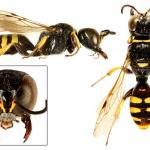Crabro bojus (SCHRANK,1802); Corenocrabro ectemiformis (TSUNEKI,1974); Crabro esakii (YASUMATSU,1942); Crabro fasciatus (COSTA,1871); Crossocerus lefebvrei LEPELETIER & BRULLÉ,1835; Blepharipus quinquemaculatus (LEPELETIER & BRULLÉ,1835); Crabro varus (Panzer,1799)
The rarest of our four Crossocerus species with yellow-marked gasters, and regarded as possibly extinct until its recent re-discovery in Hampshire and discovery in Wales.
Formerly found sparingly across southern England, from Dorset to North Lincolnshire. Now found in South Hampshire and Surrey, with a single record from Glamorgan (Crymlyn Bog). Abroad, reported across the taiga belt through Siberia to the Pacific Ocean (Lomholdt, 1975-76).
Listed as Endangered (RDB1) in Shirt (1987) and Falk (1991). This has shown one of the severest declines of any British aculeate, with only five records since the 1950s, despite earlier records for 26 vice-counties.
Probably associated with a combination of dead wood in dappled shade and damp, or, at least, lushly vegetated areas rich in craneflies. A wide variety of broad habitat types seem to be included within British data, including woodland, parkland, heathland, wetland, suburban locations and non-intensive agricultural settings.
Univoltine; late May to late July, possibly into August.
The normal prey appears to consist of craneflies, e.g. species of Tipula, Limonia and Nephrotoma. Rhagionid flies and tortricid moths are also reported as occasional prey items abroad (Lomholdt, 1975-76).
Nests occur in dead wood, often in the galleries of old beetle burrows. The nest burrows may be branched or straight. The flies are stored after their legs have been amputated (Hamm & Richards, 1926).
No information available, although males have been observed 'swarming' around shrubs and trees (but probably not to feed on blossom).
No information available.
2001


